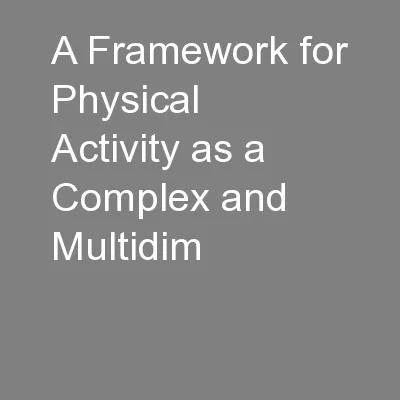

Kelley K Pettee Gabriel University of Texas Health Science Center James R Morrow Jr University of North Texas OBJECTIVES PA SelfReport Methods Hit and Miss Conceptual Framework PA ID: 343864
Download Presentation The PPT/PDF document "A Framework for Physical Activity as a C..." is the property of its rightful owner. Permission is granted to download and print the materials on this web site for personal, non-commercial use only, and to display it on your personal computer provided you do not modify the materials and that you retain all copyright notices contained in the materials. By downloading content from our website, you accept the terms of this agreement.
Slide1
A Framework for Physical Activity as a Complex and Multidimensional Behavior
Kelley K. Pettee Gabriel
University of Texas Health Science Center
James R. Morrow, Jr.
University of North TexasSlide2
OBJECTIVES
PA Self-Report Methods: ‘Hit and Miss’
Conceptual Framework: PA
Revisiting DefinitionsConsiderations: Selecting Self-report Methods
2Slide3
BACKGROUND
Research Link: PA and Health Outcomes
PA Incorporated: Design and Implementation
Need: Accurate Quantification of PALack of ‘Gold Standard’ Measure(s)
Relevant Construct Confusion
3Slide4
SELF-REPORT HIT AND “MISS”
Misconstrue
Miscount
MisstateMisjudgeMisplaceMisprintMisreadMisreportMissayMisdescribeMisguide
Misinform
Misinterpret
Misname
Misrepresent
Mischoose
Mischief
MiscommunicationMisunderstandMistakeMisleadMiscodeMisquoteMisidentifyMiscueMischievous
Individual
-
LevelPopulation-LevelSurveillance
4Slide5
framework
5Slide6
CONCEPTUAL FRAMEWORK
HUMAN MOVEMENT
Energy Expenditure
Behavior
Physical Activity
Sedentary
Human Movement
Physiological
Attributes
Physical Fitness
6Slide7
Attributes
Energy Expenditure
Physical
Fitness
Metabolic
Rate
Basal
Resting
Thermic Effect of Food
PA Related EE
Human Movement
Behavior
Physical Activity
Sedentary
Leisure
Occupational/School
Household/Caretaking/Domestic
Transportation
Discretionary
Non
Discretionary
Sitting
Media Use
Non-Occupational School
Computer Use
Sleeping
Occupation/School
Sitting
Cardiorespiratory Fitness
Flexibility
Body Composition
Muscular Fitness
Balance and Coordination
Strength
Endurance
Driving
Riding
Human Movement
Framework
7Slide8
BOUCHARD AND SHEPHARD
8
Bouchard and Shephard,1994.Slide9
LaMonte & Ainsworth, MSSE, June 2001
.
LAMONTE and AINSWORTH
9Slide10
PHYSICAL ACTIVITY
MODEL COMPARISON
Bouchard & Shephard 1994
LaMonte & Ainsworth
2001
Pettee Gabriel & Morrow
2010
Main Construct
Health-Related Fitness
Movement
Movement
Sedentary Behavior
No
No
Yes
Relationship between
Behavior & Attributes
No
No
Yes
10
Behavior
Physical Activity
Sedentary
Human Movement
Physiological
Attributes
Physical Fitness
Energy ExpenditureSlide11
Definitions
11Slide12
DEFINITIONS
12Slide13
Page 20
Page 21
DEFINITIONS
13Slide14
Physical activity is defined as any bodily movement produced by skeletal muscles that results in energy expenditure above resting level
(Caspersen et al., 1985).
Health Enhancing Physical Activity is any form of activity that benefits health.
Health Enhancing Physical Activity is any form of physical activity that benefits health and fitness without undue harm or risk (Foster, 2000). This can be all daily activities and can, but does not necessarily, include sports. Not all physical activity is beneficial for health (Hagströmer, 2007). To be beneficial for health, physical activity should be ‘moderate’ or ‘vigorous’:
Moderate-intensity physical activity raises the heart-beat and leaves the person feeling warm and slightly out of breath. It increases the body’s metabolism to 3-6 times the resting level (3-6 MET ’s) (Cavill et al., 2006). Brisk walking, for example, has an equivalent of 4.5 MET’s (Ainsworth et al., 2000).
Vigorous-intensity physical activities enable people to work up a sweat and become out of breath. They usually involve sports or exercise, like running or fast cycling. They raise the metabolism to at least six times its resting level.
EUPHIX:EU Public Health Information & Knowledge System , version 1.11, 17 December 2009
DEFINITIONS
14Slide15
WHAT’S MISSING?
Recognition that PA is a Complex Behavior
Sedentary BehaviorPA in Context of Other Constructs of HM
Appropriate Use of Measurement Tool(s)
15Slide16
Conceptual Framework
Human Movement
Behavior
Human Movement
Physiological
Attributes
Physical Activity
Sedentary
Energy Expenditure
Physical Fitness
16
Sedentary:
Behavior that produces little to no human movement resulting in minimal (or no)
physiological gain.
Health Enhancing PA:
Activity that, when added to the light-intensity activities of daily life, produces health benefits.
Physical Activity:
The behavior that drives
human movement
which results in physiological attributes including increased physical activity-related
energy expenditure
and improved
physical fitness
. Slide17
Framework Components
17Slide18
PHYSIOLOGICAL ATTRIBUTES
Human Movement
Physiological Attributes
Energy Expenditure
Physical Fitness
Metabolic Rate
Thermic Effect of Food
PA Related EE
Basal
Resting
Cardiorespiratory
Muscular Fitness
Body Composition
Flexibility
Balance and Coordination
Strength
Endurance
Direct Measures
18Slide19
Human Movement
19
Behavior
Behavior
Physical Activity
Sedentary
Household/Caretaking/Domestic
Leisure
Occupational/School
Transportation
Sitting
Media Use
Non-Occupational & School Computer Use
Discretionary
Non-Discretionary
Sleeping
Occupation/School
Sitting
Driving
Riding
Frequency
Duration
Frequency
Duration
IntensitySlide20
Physical Activity
Transportation
Household
Caretaking
Domestic
Occupational
School
Leisure
PHYSICAL ACTIVITY DOMAINS
20Slide21
Human Movement
BEHAVIOR
Behavior
Physical Activity
Sedentary
Household/Caretaking/Domestic
Leisure
Occupational/School
Transportation
Discretionary
Non-Discretionary
Sitting
Media Use
Non-Occupational & School Computer Use
Sleeping
Occupation/School
Sitting
Driving
Riding
Physical inactivity
is not
the inverse of physical activity
Physical fitness often inferred with physical activity assessment
21Slide22
Human Movement
Self-Report
BEHAVIOR
Behavior
Physical Activity
Sedentary
Household/Caretaking/Domestic
Leisure
Occupational/School
Transportation
Discretionary
Non-Discretionary
Sitting
Media Use
Non-Occupational & School computer use
Sleeping
Occupation/School
Sitting
Driving
Riding
22
Perceived BehaviorSlide23
Considerations
23Slide24
Study Characteristics
Activity Characteristics
Instrument
Characteristics
METHODOLOGICAL ISSUES
Physical Activity
Population/Sample
Characteristics
24Slide25
Study
Characteristics
Budget
Staff Resources
Study Design
Population
Sample Size
Study Objectives
Outcomes and Confounders
Geographical Location/Seasonality
Temperature, Precipitation, Daylight Hours
METHODOLOGICAL ISSUES
STUDY CHARACTERISTICS
25Slide26
METHODOLOGICAL ISSUES
POPULATION CHARACTERISTICS
26
Population
CharacteristicsSlide27
METHODOLOGICAL ISSUES
INSTRUMENT CHARACTERISTICS
27
Instrument
Characteristics Slide28
METHODOLOGICAL ISSUES
ACTIVITY CHARACTERISTICS
28
Activity
Characteristics
Aerobic (BRFSS)
Moderate (BRFSS)
Vigorous (BRFSS)
Walking (BRFSS)
Sedentary (NHANES)
Muscular Strengthening (HP2010)
Flexibility (HP2010)
Balance & Coordination
Sports (YBRS)Slide29
Study Characteristics
Activity Characteristics
Instrument
Characteristics
METHODOLOGICAL ISSUES
Physical Activity
Population/Sample
Characteristics
29Slide30
Assessing Component(s) of Human Movement v Measuring the Whole of Human Movement and the Possible Implications.
Consider what Physical Activity
Connotes to the Health Outcomes of the General Population.Consider what Physical Activity Denotes to the Researcher or Health Practitioner.
THINK
A Complex and Multidimensional Behavior
with a Simple Message
HUMAN MOVEMENT FRAMEWORK
30Slide31
SPECIAL ACKNOWLEDGEMENT
Anne-Lorraine T. Woolsey
University of North Texas
31